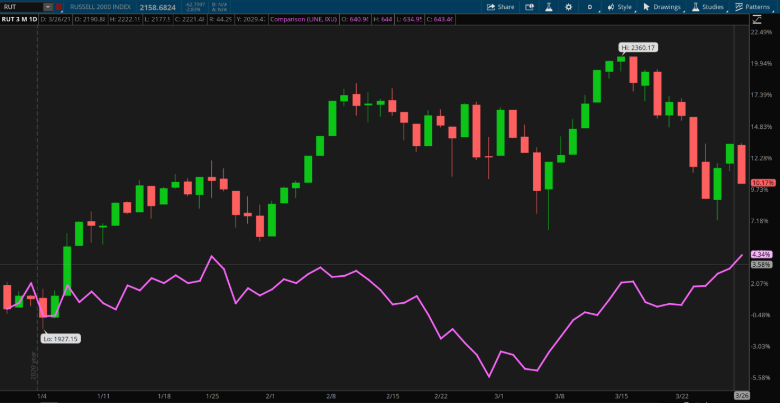It’s a new kind of “reopening trade” today as the Suez canal resumed traffic after a stuck container ship got freed. That could take pressure off of backed-up supply chains.
Major indices edged down overnight, and Tech shares took the worst of it amid rising Treasury yields. It feels like the weakness in stocks this morning could reverse quickly if the pattern we’ve seen recently continues. It’s a market that keeps going higher even though nobody seems to love it, and it’s amazing to see new record highs posted nearly every day. The old phrase, “climbing a wall of worries,” comes to mind.
Some possible catalysts awaiting their turn at bat as the new baseball season approaches include tomorrow’s expected announcement from the Biden administration on a proposed infrastructure package, the yield situation, the coming Q1 earnings season, and any potential fallout from the hedge fund rout that hit bank (and a couple media) stocks Monday.
This hedge fund episode may have reminded some investors of the fact that there’s a lot of leveraged, speculative trading in the market right now, research firm Briefing.com observed. It’s another good reason to consider taking caution if you’re planning to trade, especially with some choppiness possible the next two days before the quarter ends.
VIX Builds In More Uncertainty
All this could help explain why volatility turned higher to start the week, and why some of the more defensive sectors like Staples and Utilities topped Monday’s leaderboard. The Cboe Volatility Index (VIX) surged above 21 at times on Monday after falling below 19 to 14-month lows on Friday. It edged above 21 again early Tuesday as the 10-year Treasury yield registered a new 14-month high of 1.77%.
While the front-month VIX contract is down pretty significantly over the last few weeks, keep in mind that later-dated contracts aren’t off nearly as much from their recent highs. This could mean that longer-term uncertainty has some people keeping a premium on chances for more choppiness as spring and summer arrive, especially with the Centers for Disease Control (CDC) issuing another warning yesterday about rising Covid cases.
The jump in yields–along with a surging dollar–might reflect hopes of a stronger U.S. economy, and potentially could give bank stocks a lift after yesterday’s stumble. Investors await key U.S. jobs and manufacturing reports later this week. We’ll talk more about Friday’s payrolls report tomorrow, but see below for a preview of Thursday’s ISM manufacturing report, as well as a key Chinese PMI report on tap this week.
Earnings season is starting to dominate the conversation, too, though the main part is weeks away. This afternoon brings reports from pet food retailer Chewy Inc (NYSE: CHWY) and athletic apparel company Lululemon Athletica Inc (NASDAQ: LULU).
LULU is a particularly interesting stock to watch because many say it’s a “stay-at-home” company. However, one of the changes we’re seeing out of the pandemic is dress codes becoming even more relaxed. So is it really a “stay-at-home” stock or is the kind of apparel it sells becoming a more standard form of dress, even while working? If that’s the case, it may be able to maintain a lot of market share because of that.
CHWY will also be interesting because of the pandemic “puppy boom.” This is one to pay attention to as far as long-term prospects. Having a puppy is like having a baby–it’s a long-term commitment in terms of time and money, so let’s see what CHWY has to say about the impact.
Looking back at Monday’s scoreboard, small-caps appeared to be changing direction, starting the week out on a soft note and now down pretty sharply from highs earlier this month. The small-cap Russell 2000 (RUT) index got stomped on Monday, falling nearly 3%. Part of this reflected weakness in the banking sector, which is heavily represented in the RUT.
Also, the RUT had an amazing Q1 and now the quarter is almost over. That means there may be some profit-taking going on. Heading into the week, the RUT was up more than 12% in Q1, far outpacing all the other major indices.
One day or even a couple of weeks is never a trend, but investors might want to keep an eye on the RUT to see if it bounces back when the new quarter begins. Sometimes small-caps can be a “canary in the coalmine,” so to speak, hinting at weakness or strength ahead for the rest of the market. A good example of that came in the summer of 2018, when the RUT began softening even as a Tech rally carried other indices higher. It turned out the RUT was simply a month ahead of everyone else, and the Q4 saw a nearly 20% drop in the S&P 500 Index (SPX).
Speaking of soft, Tesla Inc (NASDAQ: TSLA) continues to lag after failing to climb above $700 on a recent rally. Now it’s down to just above $600, near its lows from earlier in March. It’s way too early to count out TSLA, which some analysts continue to have very high price targets on. But for now, it feels like it’s lost some of its luster. Same with Apple Inc (NASDAQ: AAPL) shares, which just can’t get much traction.
These two mega-caps that got so much love last year are missing the fun in 2021, but the huge upward moves in Financials and Energy have blunted the impact a bit. Those two sectors got off to a rough start this week but still look strong on the one-month chart.
CHART OF THE DAY: RUT RIPPED. Yesterday was a tough day for the Russell 2000 (RUT–candlestick) index, which fell nearly 3%. This might have had to do with some weakness in Financials, but it also could reflect profit taking in a sector that’s led all others this quarter. As this chart shows, RUT has lost ground from its mid-March high even as the more “defensive” Utilities sector (IXU–purple line) gained ground. Does this mean more caution entering the market? Data Sources: FTSE Russell, S&P Dow Jones Indices. Chart source: The thinkorswim(R) platform. For illustrative purposes only. Past performance does not guarantee future results.
Tech Sector Q1 Seen Strong: Though Tech got knocked around recently, earnings season could provide new hope for the sector if Wall Street estimates continue to look this rosy. The Tech sector overall is seen reporting earnings growth of 22.3% in Q1, and the semiconductor sub-sector of Tech looks very impressive with anticipated earnings growth of more than 24%, according to FactSet. Tuck these estimates away in your pocket for late April when the biggest surge of Tech company reporting usually occurs.
Not everyone is waiting till late April. Chipmaker Micron Technology, Inc. (NASDAQ: MU) is expected to report tomorrow afternoon. Earlier this year, MU’s CEO told CNBC the company is “in a sweet spot of market trends,” after beating analysts’ earnings and revenue estimates with its fiscal Q1 earnings. The company based its rosy guidance on the dynamic random access memory chips (DRAM) market, so tomorrow gives investors a chance to see how things went after that forecast. MU raised its guidance earlier this month. Semiconductor earnings come as the automotive industry struggles with a chip shortage. The Philadelphia Semiconductor Index (SOX) is up more than 8% so far this year, outpacing the Nasdaq Composite (COMP).
The Price of Earnings: Having earnings season right ahead could provide more of a sense of whether the major indices are priced about right or if they over- or under-shot. With the quarter nearly done, the S&P 500 Index (SPX) has a price-to-earnings ratio of around 22 vs. anticipated forward earnings. That looks on the expensive side, historically. Still, if the Q1 “E” number goes up, that could potentially raise analysts’ E projections for the year, making the current “P” look a little less pricey, if you catch the drift. Also, interest rates remain historically low, with the 10-year Treasury yield near 1.7% and expected to rise toward 2% sometime this year, according to many analysts. At levels like this, it’s easier to support a P/E above 20 for the overall market, one of them told Barron’s.
Manufacturing Check: This week brings two key manufacturing reports, one from the U.S. and the other from China. The U.S. ISM manufacturing index due out Thursday morning can sometimes move the stock market. Readings here have been running pretty hot ever since the big Covid downturn last spring, and the headline figure hit 60.8% in February. That matched the highest since February 2004, and any reading above 50% points toward expansion. Analysts expect an even firmer read for March at 61.5%, according to Briefing.com. One thing to potentially keep an eye on this time is the prices index, which jumped to 86% last time out. Any move higher could put the focus back on inflation concerns.
The same day, but earlier, comes China’s Caixin manufacturing PMI for March. This report measures factory activity in Asia’s biggest economy, and saw a slowdown in February due to the virus and weak overseas demand. It was the worst reading in nine months, so a rebound in March might bring some fresh optimism.
TD Ameritrade(R) commentary for educational purposes only. Member SIPC.
(C) 2021 Benzinga.com. Benzinga does not provide investment advice. All rights reserved.






